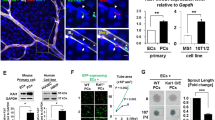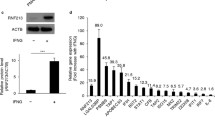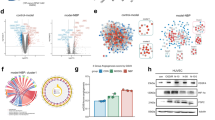Abstract
Purpose
Moyamoya disease (MMD) is one of the most common causes of pediatric stroke. We found defective angiogenic function and downregulation of retinaldehyde dehydrogenase 2 (RALDH2) in MMD endothelial colony-forming cells (ECFCs). Downregulation of RALDH2 mRNA was caused by decreased binding of acetyl-histone H3 (Ac-H3) to the RALDH2 promoter. In this study, we evaluated the feasibility of using a histone deacetylase (HDAC) inhibitor, panobinostat, to upregulate RALDH2 expression and restore the angiogenic potential of MMD ECFCs.
Methods
ECFCs from healthy normal controls and patients with MMD were isolated and characterized. After panobinostat treatment, western blot, tube formation, and chromatin immunoprecipitation (ChIP) assays were conducted in vitro. A matrigel plug assay was performed in vivo.
Results
Panobinostat increased the levels of Ac-H3 and Ac-H4 in both normal and MMD ECFCs but was much more effective in MMD ECFCs. Increased expression of RALDH2 by panobinostat was observed only in MMD ECFCs. Panobinostat increased the tube formation of both normal and MMD ECFCs in vitro and in vivo, but the effect was greater with MMD ECFCs.
Conclusions
We demonstrated that panobinostat increases the angiogenic ability of MMD ECFCs by regulating RALDH2 acetylation. Our results suggest that panobinostat might be a potent therapeutic option for MMD patients.





Similar content being viewed by others

References
Kim JS (2016) Moyamoya disease: epidemiology, clinical features, and diagnosis. J Stroke 18:2–11
Ismail I, Al-Khafaji K, Mutyala M, Aggarwal S, Al-Khafaji N, Kovacs D, Khosla S, Arora R (2015) “Smoke in the air”: a rare cerebrovascular cause of neurological signs and symptoms in a young adult. J Community Hosp Intern Med Perspect 5:27664
Ma YG, Zhang Q, Yu LB, Zhao JZ (2016) Role of ring finger protein 213 in moyamoya disease. Chin Med J 129:2497–2501
Rafat N, Beck G, Pena-Tapia PG, Schmiedek P, Vajkoczy P (2009) Increased levels of circulating endothelial progenitor cells in patients with moyamoya disease. Stroke 40:432–438
Yamashita M, Oka K, Tanaka K (1983) Histopathology of the brain vascular network in moyamoya disease. Stroke 14:50–58
Kim JH, Jung JH, Phi JH, Kang HS, Kim JE, Chae JH, Kim SJ, Kim YH, Kim YY, Cho BK, Wang KC, Kim SK (2010) Decreased level and defective function of circulating endothelial progenitor cells in children with moyamoya disease. J Neurosci Res 88:510–518
Lee JY, Moon YJ, Lee HO, Park AK, Choi SA, Wang KC, Han JW, Joung JG, Kang HS, Kim JE, Phi JH, Park WY, Kim SK (2015) Deregulation of retinaldehyde dehydrogenase 2 leads to defective angiogenic function of endothelial colony-forming cells in pediatric moyamoya disease. Arterioscler Thromb Vasc Biol 35:1670–1677
Fraineau S, Palii CG, Allan DS, Brand M (2015) Epigenetic regulation of endothelial-cell-mediated vascular repair. FEBS J 282:1605–1629
Fraineau S, Palii CG, McNeill B, Ritso M, Shelley WC, Prasain N, Chu A, Vion E, Rieck K, Nilufar S, Perkins TJ, Rudnicki MA, Allan DS, Yoder MC, Suuronen EJ, Brand M (2017) Epigenetic activation of pro-angiogenic signaling pathways in human endothelial progenitors increases vasculogenesis. Stem Cell Rep 9:1573–1587
Prasain N, Meador JL, Yoder MC (2012) Phenotypic and functional characterization of endothelial colony forming cells derived from human umbilical cord blood. J Vis Exp
Atadja P (2009) Development of the pan-DAC inhibitor panobinostat (LBH589): successes and challenges. Cancer Lett 280:233–241
Javed MJ, Mead LE, Prater D, Bessler WK, Foster D, Case J, Goebel WS, Yoder MC, Haneline LS, Ingram DA (2008) Endothelial colony forming cells and mesenchymal stem cells are enriched at different gestational ages in human umbilical cord blood. Pediatr Res 64:68–73
Seo YJ, Kang Y, Muench L, Reid A, Caesar S, Jean L, Wagner F, Holson E, Haggarty SJ, Weiss P, King P, Carter P, Volkow ND, Fowler JS, Hooker JM, Kim SW (2014) Image-guided synthesis reveals potent blood-brain barrier permeable histone deacetylase inhibitors. ACS Chem Neurosci 5:588–596
Fischer A, Sananbenesi F, Mungenast A, Tsai LH (2010) Targeting the correct HDAC(s) to treat cognitive disorders. Trends Pharmacol Sci 31:605–617
Qian DZ, Kato Y, Shabbeer S, Wei Y, Verheul HM, Salumbides B, Sanni T, Atadja P, Pili R (2006) Targeting tumor angiogenesis with histone deacetylase inhibitors: the hydroxamic acid derivative LBH589. Clin Cancer Res 12:634–642
Gray SG, Ekstrom TJ (2001) The human histone deacetylase family. Exp Cell Res 262:75–83
Joshi P, Greco TM, Guise AJ, Luo Y, Yu F, Nesvizhskii AI, Cristea IM (2013) The functional interactome landscape of the human histone deacetylase family. Mol Syst Biol 9:672
Lee YE, Choi SA, Kwack PA, Kim HJ, Kim IH, Wang KC, Phi JH, Lee JY, Chong S, Park SH, Park KD, Hwang DW, Joo KM, Kim SK (2017) Repositioning disulfiram as a radiosensitizer against atypical teratoid/rhabdoid tumor. Neuro-Oncology 19:1079–1087
Lee C, Lee J, Choi SA, Kim SK, Wang KC, Park SH, Kim SH, Lee JY, Phi JH (2018) M1 macrophage recruitment correlates with worse outcome in SHH medulloblastomas. BMC Cancer 18:535
Wang Z, Zang C, Rosenfeld JA, Schones DE, Barski A, Cuddapah S, Cui K, Roh TY, Peng W, Zhang MQ, Zhao K (2008) Combinatorial patterns of histone acetylations and methylations in the human genome. Nat Genet 40:897–903
Karlic R, Chung HR, Lasserre J, Vlahovicek K, Vingron M (2010) Histone modification levels are predictive for gene expression. Proc Natl Acad Sci U S A 107:2926–2931
Eckschlager T, Plch J, Stiborova M, Hrabeta J (2017) Histone deacetylase inhibitors as anticancer drugs. Int J Mol Sci 18
Bolden JE, Peart MJ, Johnstone RW (2006) Anticancer activities of histone deacetylase inhibitors. Nat Rev Drug Discov 5:769–784
Kuo MH, Allis CD (1998) Roles of histone acetyltransferases and deacetylases in gene regulation. Bioessays 20:615–626
Deroanne CF, Bonjean K, Servotte S, Devy L, Colige A, Clausse N, Blacher S, Verdin E, Foidart JM, Nusgens BV, Castronovo V (2002) Histone deacetylases inhibitors as anti-angiogenic agents altering vascular endothelial growth factor signaling. Oncogene 21:427–436
Rossig L, Li H, Fisslthaler B, Urbich C, Fleming I, Forstermann U, Zeiher AM, Dimmeler S (2002) Inhibitors of histone deacetylation downregulate the expression of endothelial nitric oxide synthase and compromise endothelial cell function in vasorelaxation and angiogenesis. Circ Res 91:837–844
Mottet D, Bellahcene A, Pirotte S, Waltregny D, Deroanne C, Lamour V, Lidereau R, Castronovo V (2007) Histone deacetylase 7 silencing alters endothelial cell migration, a key step in angiogenesis. Circ Res 101:1237–1246
Bapat SA (2013) Epigenetic regulation of cancer stem cell gene expression. Subcell Biochem 61:419–434
Bouvard C, Gafsou B, Dizier B, Galy-Fauroux I, Lokajczyk A, Boisson-Vidal C, Fischer AM, Helley D (2010) Alpha6-integrin subunit plays a major role in the proangiogenic properties of endothelial progenitor cells. Arterioscler Thromb Vasc Biol 30:1569–1575
Palii CG, Vulesevic B, Fraineau S, Pranckeviciene E, Griffith AJ, Chu A, Faralli H, Li Y, McNeill B, Sun J, Perkins TJ, Dilworth FJ, Perez-Iratxeta C, Suuronen EJ, Allan DS, Brand M (2014) Trichostatin A enhances vascular repair by injected human endothelial progenitors through increasing the expression of TAL1-dependent genes. Cell Stem Cell 14:644–657
Funding
This research was supported by a grant from the Korea Health Technology R&D Project through the Korea Health Industry Development Institute (KHIDI), funded by the Ministry of Health & Welfare, Republic of Korea (grant number: HI12C0066).
Author information
Authors and Affiliations
Corresponding author
Ethics declarations
Blood samples from MMD patients (N = 5) and healthy controls (N = 5) were obtained (Table 1) with informed consent under the Institutional Review Board (IRB) of the Seoul National University Hospital (SNUH IRB approval number 1610-108-801).
Conflict of interest
The authors have no financial conflicts of interest.
Additional information
Publisher’s note
Springer Nature remains neutral with regard to jurisdictional claims in published maps and institutional affiliations.
Rights and permissions
About this article
Cite this article
Jangra, A., Choi, S.A., Koh, E.J. et al. Panobinostat, a histone deacetylase inhibitor, rescues the angiogenic potential of endothelial colony-forming cells in moyamoya disease. Childs Nerv Syst 35, 823–831 (2019). https://doi.org/10.1007/s00381-019-04099-y
Received:
Accepted:
Published:
Issue Date:
DOI: https://doi.org/10.1007/s00381-019-04099-y



